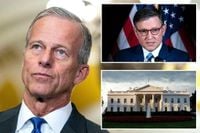On March 25, 2025, Congressional Republicans announced a significant consensus on a legislative package that aims to increase the nation's debt limit, extend tax cuts, deregulate energy policies, and enhance border enforcement. This ambitious plan, which is expected to be passed through a budget reconciliation process, is seen as a crucial step in advancing President Donald Trump's economic agenda.
Senate Majority Leader John Thune (R-SD) expressed optimism about the bipartisan support for the bill during a press conference, stating, "I don’t want to speak for the White House, but I think there’s consensus." This sentiment was echoed by House Speaker Mike Johnson (R-La.) and several GOP committee chairs who met with Thune at the White House to finalize the details of the legislation.
The proposed legislation is particularly notable as it seeks to consolidate various provisions into a single, filibuster-proof resolution. This approach is designed to bypass the typical 60-vote threshold required to overcome a filibuster in the Senate, allowing the bill to pass with a simple majority. The debt ceiling, which was previously suspended under a 2023 agreement until January 1, 2025, is a central component of the package. The Treasury Department has indicated that the U.S. will not default on its debt until mid-July 2025, thanks to extraordinary measures currently in place.
Despite previous attempts to pass separate resolutions, including a $345 billion "skinny" resolution that did not address the debt limit or tax cuts, Republicans are now rallying around a unified strategy. The House GOP recently passed a $4.5 trillion budget resolution that included $4 trillion earmarked for raising the debt ceiling, setting the stage for a comprehensive legislative effort.
Thune and Johnson are confident that the bill will be ready for a vote within the next month, with Johnson stating, "It sounds like Senate Republicans are coming around on" the debt ceiling. This marks a shift in the Senate's approach, as GOP leaders recognize the need to align with the House's broader agenda.
In a public statement on March 24, 2025, Johnson urged Senate Republicans to align with the House's budget plan, emphasizing the importance of moving swiftly to enact Trump's full agenda. "The American people gave us a mandate and we must act on it," he declared. Johnson's push reflects a growing sentiment among House leaders that splitting the debt ceiling increase from the larger package could weaken their leverage in negotiations.
As the reconciliation process unfolds, both chambers face the challenge of crafting legislation that can withstand scrutiny from the Senate parliamentarian. The Republicans are keen to avoid pitfalls that could derail key provisions of the bill. Johnson aims to have the legislation on Trump's desk by Memorial Day 2025, a timeline that underscores the urgency of their efforts.
Looking ahead, Thune has set an April 11, 2025, deadline for a final agreement between House and Senate Republicans on the budget resolution that will underpin Trump's "one, big, beautiful" tax-cut bill. This package is expected to include a range of initiatives focused on border security, deportations, energy reform, and military spending.
However, challenges remain. Critics within the party have pointed out that the House budget resolution does not make the Trump tax cuts permanent, a significant concern for many conservatives. Furthermore, the current policy baseline proposed by Senate Finance Committee Chair Mike Crapo is designed to ensure that tax cuts are implemented on a deficit-neutral basis, a strategy that has drawn mixed reactions.
President Trump has made ambitious promises regarding tax reforms, including tax-free tips, overtime, Social Security benefits, a 15% 'Made in America' corporate tax cut, and 100% retroactive expensing for factories. These proposals, while popular among his base, face hurdles in their integration into the legislative package.
As both chambers of Congress work towards a final agreement, the stakes are high. The potential for a comprehensive tax reform bill that aligns with Trump's vision could reshape the economic landscape. However, the path to achieving this goal is fraught with complexities, requiring careful negotiation and collaboration between House and Senate Republicans.
In conclusion, the consensus reached by Congressional Republicans on the debt limit and tax cuts represents a pivotal moment in the legislative process. With the clock ticking towards the mid-July deadline, the pressure is on for GOP leaders to deliver on their promises and secure a path forward for Trump's economic agenda.





